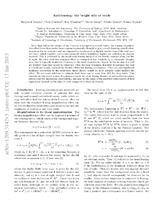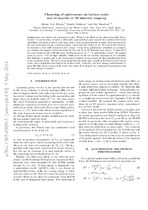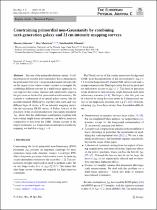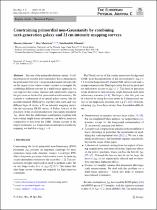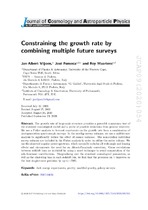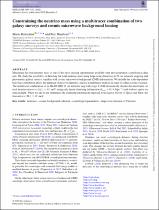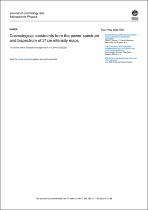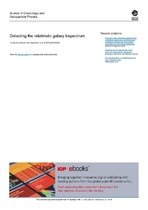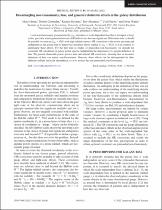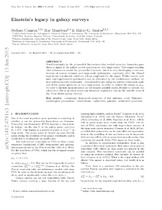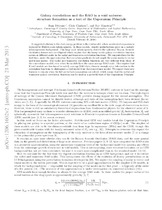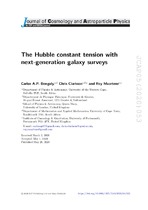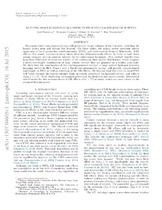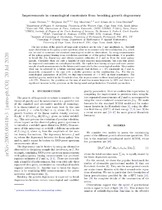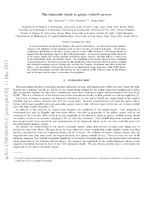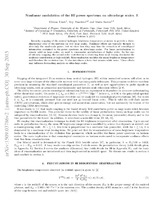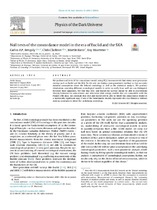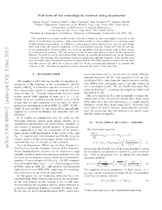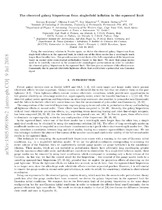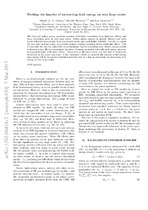Browsing Research Articles (Physics) by Author "Maartens, Roy"
Now showing items 1-20 of 23
-
Anti-lensing: the bright side of voids
Bolejko, Krzysztof; Clarkson, Chris; Maartens, Roy; Bacon, David; Meures, Nikolai; Beynon, Emma (American Physical Society, 2013)More than half of the volume of our Universe is occupied by cosmic voids. The lensing magni ca- tion e ect from those under-dense regions is generally thought to give a small dimming contribution: objects on the far side ... -
Clustering of quintessence on horizon scales and its imprint on HI intensity mapping
Duniya, Didam G.A.; Bertacca, Daniele; Maartens, Roy (IOP Science, 2013)Quintessence can cluster only on horizon scales. What is the effect on the observed matter distribution? To answer this, we need a relativistic approach that goes beyond the standard Newtonian calculation and deals properly ... -
Constraining primordial non-Gaussianity by combining next-generation galaxy and 21 cm intensity mapping surveys
Sheean, Jolicoeur; Maartens, Roy; Jolicoeur, Sheean; Dlamini, Simthembile (Institute for Ionics, 2023)Surveys of the matter distribution contain ‘fossil’ information on possible non-Gaussianity that is generated in the primordial universe. This primordial signal survives only on the largest scales where cosmic variance ... -
Constraining primordial non-gaussianity by combining next-generation galaxy and 21 cm intensity mapping surveys
Jolicoeur, Sheean; Maartens, Roy; Dlamini, Simthembile (SpringerOpen, 2023)Surveys of the matter distribution contain ‘fossil’ information on possible non-Gaussianity that is generated in the primordialUniverse. This primordial signal survives only on the largest scales where cosmic variance ... -
Constraining the growth rate by combining multiple future surveys
Viljoen, Jan-Albert; Fonseca, Jos´e; Maartens, Roy (IOP Publishing, 2020)The growth rate of large-scale structure provides a powerful consistency test of the standard cosmological model and a probe of possible deviations from general relativity. We use a Fisher analysis to forecast constraints ... -
Constraining the neutrino mass using a multitracer combination of two galaxy surveys and cosmic microwave background lensing
Ballardini, Mario; Maartens, Roy (Oxford University Press, 2022)Measuring the total neutrino mass is one of the most exciting opportunities available with next-generation cosmological data sets. We study the possibility of detecting the total neutrino mass using large-scale clustering ... -
Cosmological constraints from the power spectrum and bispectrum of 21cm intensity maps
Karagiannis, Dionysios; Maartens, Roy; Randrianjanahary, Liantsoa F. (IOP Publishing, 2022)The 21cm emission of neutral hydrogen is a potential probe of the matter distribution in the Universe after reionisation. Cosmological surveys of this line intensity will be conducted in the coming years by the SKAO and ... -
Detecting the relativistic galaxy bispectrum
Maartens, Roy; Jolicoeur, Sheean; Umeh, Obinna (IOP Publishing Ltd, 2020)The Fourier galaxy bispectrum is complex, with the imaginary part arising from leading-order relativistic corrections, due to Doppler, gravitational redshift and related lineof-sight effects in redshift space. The detection ... -
Disentangling non-gaussianity, bias, and general relativistic effects in the galaxy distribution
Bruni, Marco; Crittenden, Robert; Maartens, Roy (American Physical Society, 2012)Local non-Gaussianity, parametrized by f NL , introduces a scale-dependent bias that is strongest at large scales, precisely where general relativistic (GR) effects also become significant. With future data, it should ... -
Einstein's legacy in galaxy surveys
Camera, Stefano; Maartens, Roy; Santos, Mario G. (Oxford University Press, 2015)Non-Gaussianity in the primordial fluctuations that seeded structure formation produces a signal in the galaxy power spectrum on very large scales. This signal contains vital information about the primordial Universe, but ... -
Galaxy correlations and the BAO in a void universe: structure formation as a test of the Copernican Principle
February, Sean; Clarkson, Chris; Maartens, Roy (IOP Science, 2013)A suggested solution to the dark energy problem is the void model, where accelerated expansion is replaced by Hubble-scale inhomogeneity. In these models, density perturbations grow on a radially inhomogeneous background. ... -
The Hubble constant tension with next-generation galaxy surveys
Bengaly, Carlos A.P.; Clarkson, Chris; Maartens, Roy (IOP Publishing Ltd, 2020)The rate at which the universe is expanding today is a fundamental parameter in cosmology which governs our understanding of structure formation and dark energy. However, current measurements of the Hubble constant, H0, ... -
Hunting down horizon-scale effects with multi-wavelength surveys
Fonseca, Jose; Camera, Stefano; Santos, Mario G.; Maartens, Roy (American Astronomical Society, 2015)Next-generation cosmological surveys will probe ever larger volumes of the universe, including the largest scales, near and beyond the horizon. On these scales, the galaxy power spectrum carries signatures of local primordial ... -
Improvements in cosmological constraints from breaking growth degeneracy
Perenon, Louis; Ilic, St´ephane; Maartens, Roy (EDP Sciences, 2020)The key probes of the growth of a large-scale structure are its rate f and amplitude σ8. Redshift space distortions in the galaxy power spectrum allow us to measure only the combination fσ8, which can be used to constrain ... -
The kinematic dipole in galaxy redshift surveys
Maartens, Roy; Clarkson, Chris; Chen, Song (IOP Publishing, 2018)In the concordance model of the Universe, the matter distribution { as observed in galaxy number counts or the intensity of line emission (such as the 21cm line of neutral hydrogen) - should have a kinematic dipole due ... -
Nonlinear modulation of the HI power spectrum on ultra-large scales. I
Umeh, Obinna; Maartens, Roy; Santos, Mario G. (IOP Science, 2015)Intensity mapping of the neutral hydrogen brightness temperature promises to provide a three-dimensional view of the universe on very large scales. Nonlinear effects are typically thought to alter only the small-scale ... -
Null tests of the concordance model in the era of Euclid and the SKA
Bengaly, Carlos; Clarkson, Chris; Kunz, Martin; Maartens, Roy (Elsevier, 2021)We perform null tests of the concordance model, using H (z) measurements that mimic next-generation surveys such as Euclid and the SKA. To this end, we deploy a non-parametric method, so that we make minimal assumptions ... -
Null tests of the cosmological constant using supernovae
Yahya, Sahba; Seikel, Marina; Clarkson, Chris; Maartens, Roy; Smith, Mathew (American Physical Society, 2014)The standard concordance model of the Universe is based on the cosmological constant as the driver of accelerating expansion. This concordance model is being subjected to a growing range of inter-locking observations. ... -
The observed galaxy bispectrum from single-field inflation in the squeezed limit
Koyama, Kazuya; Umeh, Obinna; Maartens, Roy; Bertacca, Daniele (IOP Publishing, 2018)Using the consistency relation in Fourier space, we derive the observed galaxy bispectrum from single- eld in ation in the squeezed limit, in which one of the three modes has a wavelength much longer than the other two. ... -
Probing the imprint of interacting dark energy on very large scales
Duniya, Didam, G. A.; Bertacca, Daniele; Maartens, Roy (American Physical Society, 2015)The observed galaxy power spectrum acquires relativistic corrections from light-cone effects, and these corrections grow on very large scales. Future galaxy surveys in optical, infrared and radio bands will probe increasingly ...

